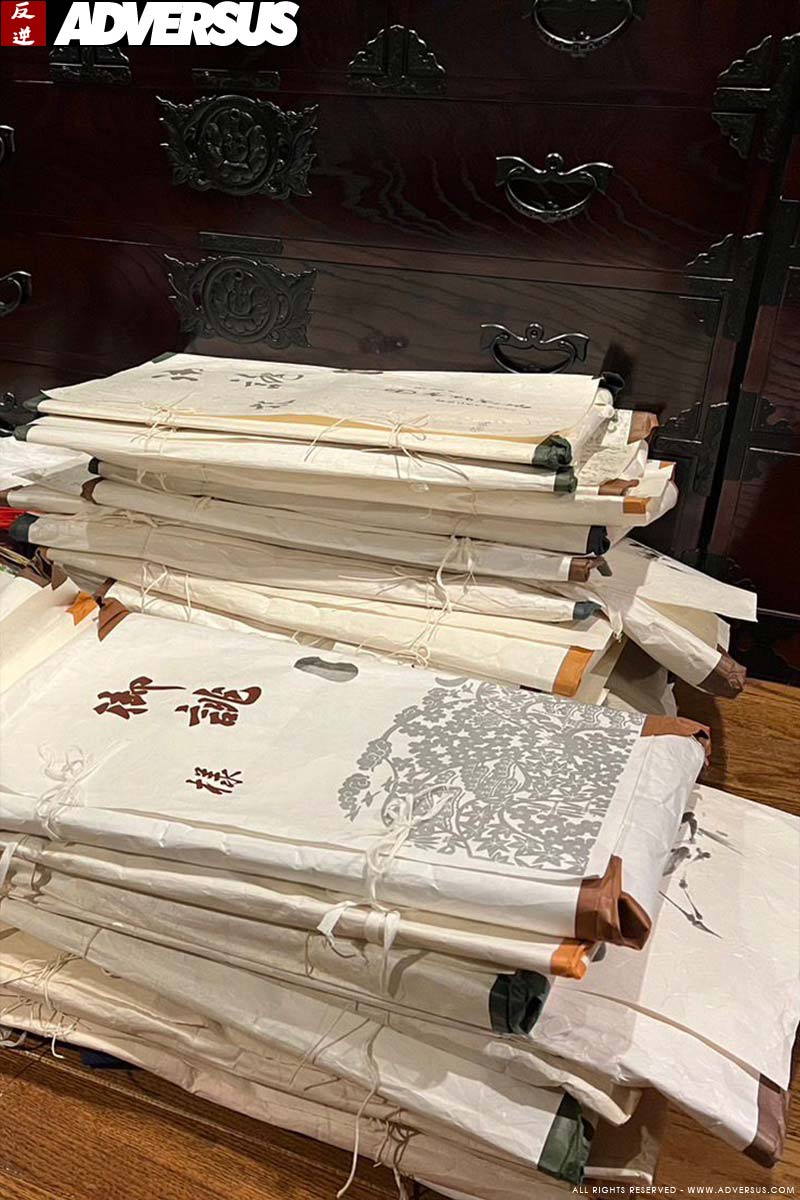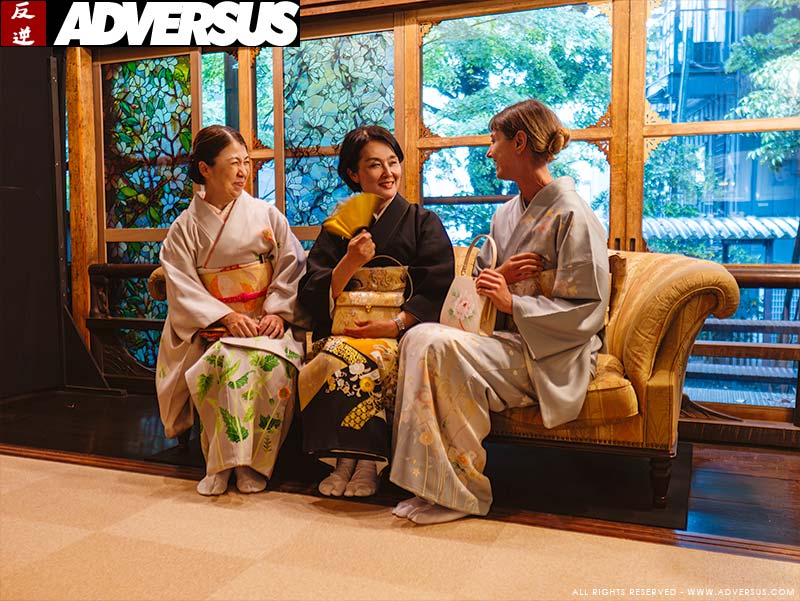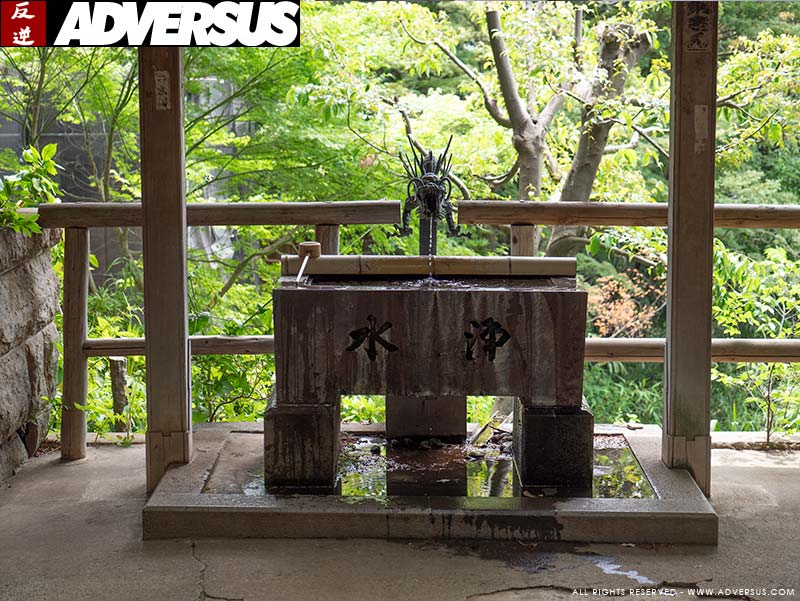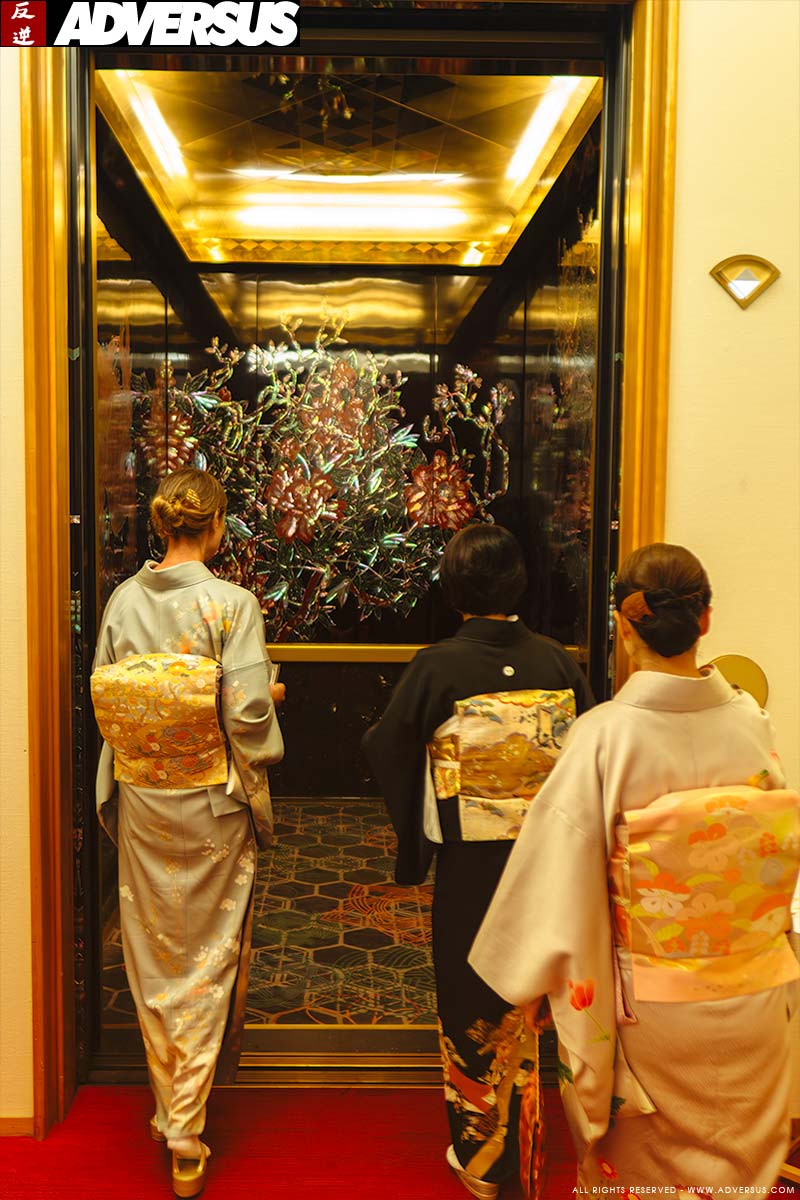
It all started with a WhatsApp from my dearest Japanese friend Tomoko: ‘My best friend Yoko-san has kimonos ready for you,’ she wrote. ‘She asked if I would give it to you when I come to Japan. She is busy cleaning up her grandparents’ house.’ What do you say to that? A resounding ‘Yes, yes, thanks! Dōmo arigatōgozaimasu!’ of course.
Kimono Party
Shortly afterwards I received photos showing dozens of silk kimonos and beautiful kimono belts, obis. ‘Let me know which one you like.” Because I couldn’t choose, Tomoko organized a video chat with Yoko and her in which they showcased several kimonos. In the end I chose a white kimono with hydrangeas, a green obi with white blossoms and a soft pink obi with on it an image of Mount Fuji with its always snow-covered crater. “Pick another one!” And another one!’ I couldn’t wait to go to Japan.

By the time Alessio (aka ADVERSUS) and I had booked a flight to Tokyo – something that had been planned for a long time – I had already suggested that Yoko, Tomoko and I would put on the kimonos and that Alessio would photograph us in this traditional Japanese garment. My proposal was naïve, to say the least. At the time I didn’t know that you don’t just throw on a kimono, that only a few Japanese women can dress themselves in it and that even for a professional kimono dresser, a sensei, it takes more or less one hour to dress someone in a kimono.
I found that out little by little. And one thing led to another. Tomoko arranged for a professional dresser, Ando-san. This gave rise to the idea that we would film the dressing session, as a kind of documentary. The Japanese perfectionism of my friend Tomoko and her friends led to me renting a kimono that suited my height and waist, because Yoko’s grandmother’s silk kimonos were beautiful and could easily be turned into dresses, but if traditionally worn, they were too short for me according to strict Japanese standards.
Renting a silk kimono costs about 125 Euro, all accessories (obi, underwear, tabi socks, slippers and bag), dry cleaning and insurance included. Choosing the right kimono is a deadly serious matter. Tomoko, her friend Mayuko and sensei Ando-san brainstormed (‘agonized’ was the word they used) about it for more than an hour. Eventually it became a soft green kimono with a gold-colored obi. Ando-san and Mayuko (who would help Ando-san) didn’t mind us filming while we were dressing.
In the meantime, I wanted to know more about kimonos in contemporary Japan. During my previous visits to Japan, about ten or fifteen years ago, I had admired elderly ladies in kimono on the street – the young people no longer wore them every day – and in Kyoto in 2010 I had made a photo report of geishas and maikos. Back then I was especially intrigued by the hairstyle – to maintain this hairstyle, geisha sleep on a wooden pillow – and the white make-up with a little nude skin in the neck, the most erotic female zone in Japan. The kimono was unknown territory for me.
For our kimono project, which we had now baptized ‘Kimono Party’, I sent some questions to Tomoko, who enthusiastically distributed them among her Japanese friends. Soon the replies started pouring in, some in English, some in Japanese. It were interesting answers, moving answers, technical answers, answers from Tomoko’s mother, stories about grandmothers who wore kimonos with the perfume of sandalwood, a scent that I got to know in Tokyo.
It was the beginning of a search for the role of the kimono in modern Japanese society, not only for me but also for Tomoko and her extensive circle of friends. Everyone contributed a little and it ended in ‘happy tears’, tears of joy. But let me not get ahead of things.
The kimono nowadays

From the answers I understood that there are special moments in the life of contemporary Japanese society when a kimono is worn. Weddings, funerals and traditional celebrations, such as the 3-5-7 Ceremony (Shichi-go-san) for which children in their third, fifth or seventh year of life are photographed in kimono, and the Coming Of Age Day (Seijin-shiki) when the moment (in kimono) celebrates when young people reach adulthood.
In the answers I also kept coming across sentences such as ‘The kimono is in our DNA’. The best answer was from Yufuko who wrote: ‘When I opened the wrapping of kimono after 30 years since last time I felt like I opened a time capsule. When I wore a kimono after 30 years, the faint sound of rubbing clothes hit my DNA as Japanese.’
While reading, it also became clear to me why today’s Japanese youth are getting rid of the kimonos that have been handed down from generation to generation and are often made of precious silk, as was Yoko’s case. To keep the kimonos, which often had cost fortunes, they have to be kept in special boxes or cupboards and these take up a lot of space. Nowadays that is not feasible in Japan, where the houses are very small. Cleaning kimonos is also expensive. Another reason why kimonos are disappearing from the picture is, as mentioned, that there are very few Japanese women who can dress themselves. So costs have to be incurred to get dressed. Not to mention the time involved.
Junko writes: ‘Putting on a kimono is not easy, and you cannot do it alone, so you have to ask someone who knows how to put it on, or if you want to wear it yourself, you have to go to a kimono class and learn how to wear it correctly.’

The same goes for Chizuyo: ‘I learned how to put on a kimono in my 20s. So I tried to wear it just by myself to attend a friend’s wedding party. But unfortunately it took hours to put it on. During living in Germany, we celebrated our son’s Shichi-go-san there wearing kimonos we brought from Japan.’
Mayuko summarizes it as follows: ‘Not everyone has the skills to put it on, and even if they do wear it, it is expensive. You must prepare (purchase or rent) a kimono and prepare to wear it.
★Issues in modern Japanese society
① The current shape of the kimono is not functional for daily life.
②It is difficult to put on a kimono and you cannot do it by yourself.
③ There are a lot of detailed rules when it comes to coordination and dressing, which makes it feel troublesome.
④High price.
⑤ Maintenance including washing is troublesome.’
Despite everything, it is not easy to get rid of kimonos that have been handed down from generation to generation. Many kimonos are made of precious silk and the patterns are true works of art that often depict magical stories.
In her answers, Yumiko tells more about the beautiful patterns that can be found on kimonos: ‘Kimono craftsmen have created a lot of different fabrics and patterns. The material for their kimonos is silk, a specialty of Japan. Many kimono patterns were devised using different materials depending on the region. The kimono is the result of the accumulated ingenuity of craftsmen, and their pride is symbolized in the kimono.
The patterns match the seasons of the year, Shiho-chan explains. ‘The kimono is seasonal, so you need to match it with the season. However, wearing a plain kimono is suitable for all seasons.’
And then there’s something else. All these beautiful kimonos have fond memories attached to them.
Shiho-chan writes: My grandmother wore a kimono on a daily basis. When she woke up in the morning, it took her less than 10 minutes to put on a kimono, which is very cool. I looked forward to watching it every morning. All the kimonos my grandmother wore had the scent of sandalwood. Even now, when I smell sandalwood, I feel close to my grandmother.’
Toshiko-san, Tomoko’s mother, remembers her mother wearing a kimono every day. ‘In her house there were many kimonos in a paulownia wooden chest of drawers. There was a room where you could put your kimono on.’
Mayuko confirms that today there are not many people who still wear a kimono every day. ‘There are people who wear kimono for work, but there are not many people who wear kimono most of the time as everyday wear. People like that existed 30 to 40 years ago.’
Despite this, the kimono is inextricably linked to Japanese culture. “The appeal of the kimono is that it expresses the aesthetic sense of Japan,” writes Mayuko, “which has four seasons, and the patterns and designs that have been refined over a long history express the deep Japanese culture. By wearing a kimono, you will naturally stretch your back and develop beautiful movements. Precisely because our movements are restricted, we have to be mindful of our surroundings. The idea that kimono is worn to entertain others, and the Japanese spirit of hospitality, may be in common with this idea.’
Preparations for the Kimono Party
In the meantime, we had set a date for our Kimono Party in Tokyo: May 13, 2024. Tomoko turns out to be the perfect party planner. I get instructions on how to reach her house (Tokyo is huge), she comes up with solutions for me to transport the kimonos – there are now six (!) of them and they come with all kinds of accessories –, she prepares a lunch (Tomoko-san is a master chef) to celebrate our reunion after eight years and makes a time schedule so that the three of us (she, Yoko and I) will be all dressed in kimonos by lunchtime.

On that particular day of May 13, Tomoko will wear the black kuro-tomesode that her mother gave her as a gift on the day of her wedding and which she will wear on the day of her son’s wedding. The kimono shows the family crest of her father’s side. Five times, to be exact (that’s the rule, and rules are sacred in Japan). In preparation for the Kimono Party, Mayuko and Ando-san prepared Tomoko’s kuro-tomesode days in advance. Tomoko had never worn her kuro-tomesode and the seams still needed to be undone. The kimono also had to be hung out so that the wrinkles would disappear. It was a dressing rehearsal, with the necessary emotions. The next day Tomoko wrote:

Honestly; I do not have the expertise to discuss kimonos, but I would like to share my experience of wearing my kuro-tomesode with Mayuko and Ms. Ando.
To wear a kimono, a variety of accessories (undergarments, etc.) are required, and assistance is needed for dressing. Mayuko had prepared the necessary accessories in advance, which facilitated the process of putting on the kimono smoothly.
The kimono I wore was brand new (a wedding gift from my mother, a black tomesode adorned with my father’s family crest), so it took some time to put on. Untying the threads and adjusting the collar took a bit of time, but with Ms. Ando’s expertise, it was soon arranged beautifully for me to wear on the 13th, the day of the event.
In total, it took 45 minutes to dress in the kimono.
I appreciated the meticulous care taken with this valuable garment. It felt comfortable to wear, which I attribute to Ms. Ando’s skill.
I cannot buy myself an expensive silk kimono myself, and the intricate process of wearing one is also a challenge. The effort and cost involved may explain why many Japanese have gradually moved away from wearing kimonos.
BUT when I put on a kimono, I feel very comfortable, and above all, it is far more gorgeous than regular clothes, really.
I just wanted to share my thoughts from yesterday. Thank you for listening me!
Love, Tomoko
Reunion with Tokyo and Tomoko
Meeting Tomoko again was exciting and easy-going. It was as if we had seen each other yesterday instead of eight years ago when we said goodbye with a cup of coffee in Bangkok and we parted with Tomoko saying ‘No hug please, see you soon’. Tomoko, her husband Tak and all their friends moved Alessio and me with a heart-warming welcome. We celebrated our reunion on a Friday evening at a crowded izakaya in Tokyo’s trendy Aoyama district, where we feasted on yakotori (chicken on the grill) and memories.

On Sunday morning I took the subway and train (something that is not easy in Tokyo, think Lost in Translation by Sofia Coppola) to Tomoko’s house to discuss the final things for our Kimono Party. Tomoko and Tak were waiting for me at the temple of Todoroki Ravine Park, where we would take our kimono photos the next day.
Once at Tomoko’s house I was showered with gifts. The post delivered a flower arrangement from Maromi whom I had met in Bangkok years ago. What a sweet gesture! Tak had a bottle of precious sake with gold leaves from Hiroshima ready for tomorrow. Anyone who gets a gold leaf in his or her glass is lucky, he explained. The floor was littered with paper packages with kimonos from Yoko for me and my rental kimono was hanging on a wide kimono-hanger. Tomoko gave me a book about kimonos and two beautiful prints, gifts from Mayuko. It was overwhelming. Tomoko and I both were full of the Kimono Party that would take place the next day. And I just… didn’t know how to thank everybody.
Pouring rain. Preparations
That night it was storming and pouring rain in Tokyo. The Japanese spring had unexpectedly turned and a near-hurricane raged. I heard heavy rain pounding against the hotel window and couldn’t close an eye, out of excitement and despair. At half past four it was already light, a pale and muddy light. From our hotel room on the seventeenth floor I saw how the rain was still pouring down violently on the famous cemetery below (in that cemetery is also buried the famous dog Hachiko who waited faithfully for his departed owner at Shibuya station for nine years). The trees of the cemetery bent under the whipping wind and pedestrians on the neatly white zebras at the road crossings protected themselves with large umbrellas.

Until the very last moment I hesitated whether we should go to Tomoko’s by taxi or train, but given the persistent rain, our heavy photo and film equipment and my freshly washed hair and (white) make-up, we decided to take a taxi. Decisions also had to be made regarding the shooting location. The Todoroki Ravine Park temple was no longer an option. Tomoko arranged (after an idea of Mayuko and Ando-san) for photos in the Meguro Gajoen Hotel, a classic Japanese luxury hotel. It turned out to be a very good choice.
I started preparing at 7am. Mayuko had sent me some very useful tips which I translated from Japanese in English:
- Underpants are low and seamless. (If they are too high, it is difficult to pull them down in the toilet and the kimono can fall apart. And also because if they are not seamless, the lines will be visible through the kimono.)
- Bras with underwire are not recommended. The brace can touch the obi part and cause pain! Therefore, wear a sports bra or special bra for Japanese clothing.
- Use a foundation that is slightly lighter than your natural makeup. Apply powder not only on your face, but also on your neck!! (Also on the backs of your hands and ears!)
- Elongated eye makeup and strong eyebrows. Kimonos are made to fit the flat faces of Japanese people, so avoid wearing rouge. Lips have a firm contour and a natural, matte finish!
- Have a good breakfast on the day of the Kimono Party because you will be constricted and should not get dizzy.
I followed the tips as best as possible. I had bought seamless underpants and a bra in advance. Especially that bra without underwire turned out to be important because the day after our Kimono Party I really had a bit of pain in my ribs. I don’t want to think about what it would have felt like if I had worn an underwire bra. Tomoko told me that in the past, Japanese women often did not wear underwear at all under their kimono. The traditional cotton underwear (hadagi) in cotton or hemp took over that function.
Kimono Party
Our Kimono Party exceeded all expectations. With controlled and delicate gestures, Ando-san and Mayuko dressed me in the soft green kimono they had chosen for me. It was as if I had known these intelligent and sensitive women for years. From the moment I saw them, I closed them in my heart.
Dressing was an intense experience that lasted one hour (see the video). When it was the time of the obi, we discovered that it showed a phoenix, mythological bird, which we all found very intriguing. Meanwhile, Tomoko fluttered around beautifully in her black kuro-tomesode and, being the perfect hostess that she is, provided her guests with drinks and snacks.
At lunchtime Yoko arrived, beautiful and fresh in a soft gray kimono with poppies, topped with a traditional overcoat that protected her against the rain. The reason why she chose this kimono, she explained, is because in the Japanese language of flowers, it means ‘consideration’. So she chose this kimono because of the spring flowers and out of respect for herself. She was accompanied by a muscular gentleman with an exceptionally healthy appetite as it turned out during lunch, who was a professional golfer, called ‘Pro’ by everyone.

Lunch was a cornucopia of delicacies. Tomoko had prepared an Italian aperitif with all kinds of international treats and Japanese-style stewed chicken with vegetables and tofu. Yoko had brought delicious kakinoha sushi, sushi wrapped in persimmon leaves. The sushi, rectangular packages in a wooden box, were not only delicious but also looked beautiful.

Just as spectacular was the sweet red bean paste in bamboo tubes. Not to mention the orange and grapefruit jelly that Tomoko had provided and which was served in oranges and grapefruits. Tak’s sake was the icing on the cake and I secretly hoped that I would find a gold leaf in my glass. But it was mainly the conversations and exploring each other’s cultures that made the lunch an unsurpassed success. No matter how different our backgrounds, we had found each other.

‘Are you able to breathe and eat properly?’ Ando-san asked me at one point. ‘Otherwise do this.’ She said something in Japanese to Yoko, who put her hands on the sides of the obi and pressed hard. I imitated her and felt the stiff filling of the obi open up at the front and immediately got more air.
After lunch it was Yoko again who discreetly explained to me how to go to the toilet. Kimono, underkimono and underskirt together form six layers that you have to open layer by layer, like an onion. The left side goes over the right and so you open all those layers from left to right, and then again from left to right and then again, until your legs have some freedom again and you can use the toilet. The Japanese toilet with all its automatic functions is a different story, including Tomoko’s. The valve opened automatically as soon as I opened the door, the pot was lit and water spontaneously flowed from the tap to wash your hands. But this is a story apart.

It’s almost impossible to explain what it feels like to wear a kimono. Wearing a kimono makes you more feminine, elegant and even taller. I felt myself growing the moment Ando-san fixed the obi and I’m sure I gained a few inches. Indescribable is also our ride through Tokyo to the hotel with Tomoko and Yoko, both beautiful in Japanese clothing, next to me in the backseat. Pro sat at the wheel, Alessio next to him, and deftly navigated us through the soaking wet city. It felt like I was a little bit Japanese which made me proud. Meanwhile, I practiced keeping my feet close together, turned just slightly inward, as they should be.
When I arrived at the hotel, Yoko stopped me when I wanted to get out of the car. ‘Wait!’ The car sill was quickly wiped clean from the outside so that our kimonos would not get dirty. I had to focus all my attention to gracefully leave the car.

You should have seen us – Tomoko, Yoko and me – striding through the luxurious corridors of the Meguro Gajoen Hotel. It was like being in a movie. With short steps, limited by my kimono, I shuffled across the thick carpets in wedge slippers and tabi socks. The mother-of-pearl inlaid elevator took us slowly but steadily to the famous hundred steps stair and the antique rooms. There Tomoko, Yoko and I posed for the photos that would immortalize our Kimono Party. Yoko was discreet and elegant, Tomoko attracted attention everywhere with her black kuro-tomesode and official appearance. Wherever she went, she was received with elegant bows and treated with respect.
Back at Tomoko’s – it was still raining steadily – we received a warm welcome from Mayuko and Ando-san who had put everything in order in the meantime. Ando-san took off my kimono and then explained to me how to fold a kimono, which is also an art. The kimonos that Yoko gave me as a gift – the one with the hydrangeas is a dream! – were carefully wrapped and placed in large bags, along with all the other gifts. I cannot believe they spoiled me so much. We said goodbye and no thank you was ever enough.
A few days later the Kimono Party gave us another intense moment. The video stirred deep emotions and many tears in Tomoko and her friends. ‘Happy tears’ Tomoko said and I agreed. We were still reminiscing about it for days, even weeks afterwards. Tomoko called it ‘basking in the afterglow’. She couldn’t have said it better… It was an unforgettable day. Thank you, Tomoko, thank you, Yoko! Thank you all!













